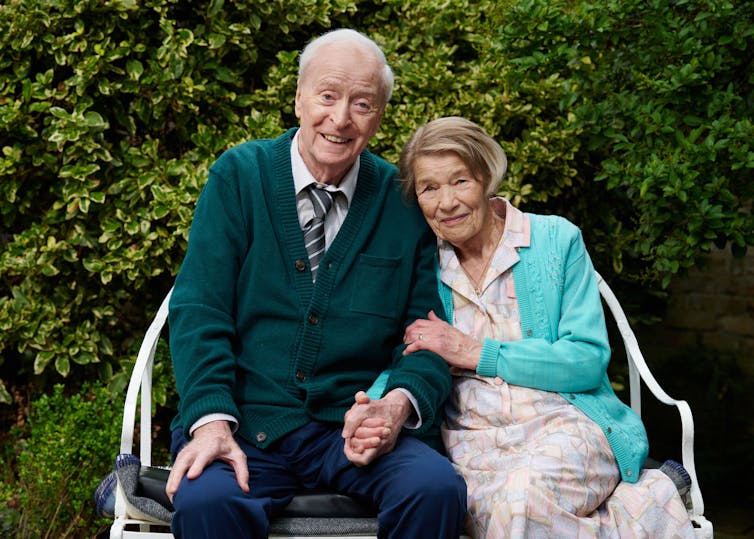The Great Escaper is an engaging exploration of love, loss, memory and trauma. It’s also the final film for its star, Michael Caine, as he has recently announced his retirement. The film tells the real story of Royal Navy veteran, Bernard Jordan, who “escaped” from his care home in June 2014 to attend the 70th anniversary of D-Day commemorations in Normandy.
The film follows Caine’s “Bernie” as he embarks upon a deeply personal and emotional reckoning with his war, a journey he undertakes with the support of his stoic wife, Irene, beautifully played by the late Glenda Jackson.
The Great Escaper uses a well-known storytelling device: the war-damaged veteran. In doing so, it marks itself as a British answer to Saving Private Ryan (1998). The film, which pays homage to the war generation, revels in forties nostalgia and stakes an assertive British claim to the memory of the Allied invasion.
Troubled homecomings
From the troubled homecoming of Homer’s Odysseus to the spate of Hollywood films produced in the 1970s and 1980s focused on the angry and alienated Vietnam veteran such as The Deer Hunter (1978) and Apocalypse Now (1979), the traumatised ex-soldier has long been a figure of cultural interest. This has especially been the case in the British film industry over the last 30 years.
Take, for instance, a trilogy of films produced in the late 1980s all of which examined the return to “civvy street” of battle-damaged Falklands veterans: Resurrected (1989), Tumbledown (1988) and For Queen and Country (1989). Or, more recent productions focused on returning soldiers, such as Outlaw (2007), The Veteran (2011) and, of course, Harry Brown (2009).
The latter starred Michael Caine as a decorated Royal Marine veteran who sets out to rid his impoverished inner-city council estate of crime.
Caine’s “Bernie” is clearly a very different figure to Harry Brown (he does nothing more controversial than letting down the tyres of antisocial cyclists). But as a film character, he nonetheless owes something to these cinematic counterparts. Like them, he carries the psychological scars of war, scars which wake him in the night and which take him back to the invasion beaches on the Normandy coast.
D-Day on film
The Normandy invasion has been subject of various films, perhaps most famously The Longest Day (1962). In the modern era, however, the D-Day film of most renown is undoubtedly Stephen Spielberg’s Saving Private Ryan (1998), which starred Tom Hanks and Matt Damon.
Intended as a homage to the “greatest generation”, the film begins with an old soldier (the titular Private Ryan) searching the graves in the vast American military cemetery overlooking Omaha Beach in Normandy. This was the scene of some of the deadliest fighting on June 6 1944.
Finding the grave he is looking for, the aged veteran drops to his knees before the camera zooms in on his eyes so that Spielberg can take us back to the battle on that grey spring morning. It is a powerful scene, and it has clearly inspired The Great Escaper’s director, Oliver Parker.
Indeed, the shadow of Saving Private Ryan looms large throughout. Like Spielberg, Parker takes us back to a Normandy burial ground, this time the Commonwealth War Graves Commission Cemetery in the town of Bayeux. He has us wander among the serried ranks of headstones and, via a series of flashbacks, we witness the carnage on the coast in washed-out colour, with the salt and sea spray in our eyes.

These similarities, I think, reveal the ultimate point of The Great Escaper. Through the familiar trope of a war-damaged British veteran, the films pays homage to those who fought and won the second world war. It’s a generation much vaunted in recent years, especially amid all the Brexit-induced forties nostalgia.
In doing so, Caine’s filmic finale also delivers an assertive British claim on the memory of D-Day (complete with obligatory digs at the “lateness” to the conflict of the American ally). In effect, it is the cinematic counterpart to the new British Normandy War Memorial, unveiled just two years ago in June 2021.
Whether or not Parker’s film goes on to have the same cultural impact as Spielberg’s award-winning production remains to be seen. But thanks to the powerful presence of Michael Caine it surely stands a decent chance.

Looking for something good? Cut through the noise with a carefully curated selection of the latest releases, live events and exhibitions, straight to your inbox every fortnight, on Fridays. Sign up here.

